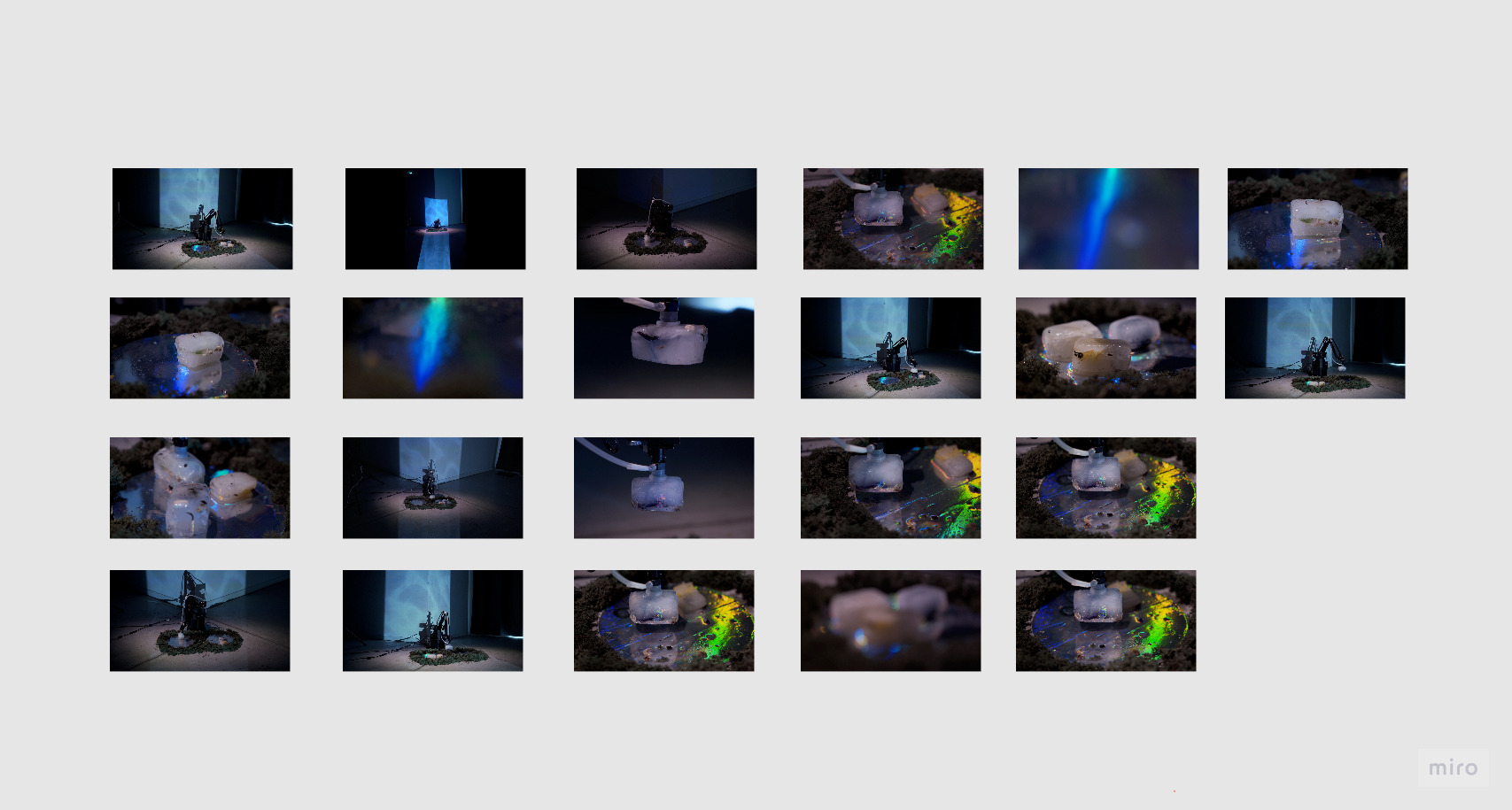MELTING DEPENDENCIES
Future Scenography installation using U-arm robotic units
Abstract
The robot arm keeps executing its task to serve humanity and constantly builds but never comes to an end, interpreting twilight as an undefined state. As nature and humanity slowly passes away due to their transience, artificial robotics keeps going, even if its purpose got lost. Will it be lost forever?
Description of the elements we used
- Ice blocks
The ice blocks represent transience, they represent human life on earth. During the installation, the ice will transform itself from a solid block to liquid water. These blocks are an artificial construction, their shape, size, and look got defined and influenced from the outside. This is a reference to us humans: We are natural beings whose life gets artificially influenced by culture and society.
- The seeds, flowers, and pinches of earth
The seeds, flowers, and pinches of earth frozen in the ice cubes represent the cycle of life. A single grain, under the right circumstances, is the source of a thousand grains. It can be stored for many years and then brought to life in days. A seed as such must be destroyed for the plant to grow. So, in a meaningful and deeper way, it must give up its own existence so that something else, more beautiful and visible, can grow. Sowing seeds is associated with an optimistic view of the future. What one sows, one expects. These elements indicate a confident view toward the future.
- Moss
Moss is the first plant to grow on rocky ground. By breaking down rocks and soil, it helps create an environment in which other plants can grow. It is an ancient form of plant life, which evolved as early as the Permian period, over 250 million years ago. It represents the permanence of nature on our planet. Moss needs a humid environment, it needs water to reproduce. In our installation, moss represents not only constancy, nature, and life, but also love and our positive, „soft“ image of the future, which we want to convey.
- Mirrors
The main activity of our Installation takes place on two mirror-foiled stages. While a robot arm lifts and repositions the ice blocks continuously, the mirrors reflect the ice blocks› lower, otherwise invisible side. This stands symbolic for the complexity of our society, but also for the narcissistic characteristic of humans. In the course of time, the ice melts. The mirrors emphasize this transformation, while they now offer full stage presence to what was hidden inside the ice blocks before. As the blocks of ice have melted, but the robot can’t change his behavior, it becomes apparent, and absurdly emphasized, how pointless the robot’s work is. This symbolizes the uselessness of the robots in the absence of humans. And thus the dependence of the robots opposite humans (instead of vice versa)!
Conclusion
We have included the task’s topic of Twilight by referencing the perceived eternal repetition – every day the sun sets and the moon rises. The transient states – the end of a specific day, the passing of time. We picked typical colors, from the transition from light to dark across its spectrum, and brought up a theme, which depth fits well to conversations that typically start around sunset and become light and thoughtful with the evolving night.
With our multi-layered installation, we want to unite different aspects and thoughts. Despite the different elements, we create a harmonious image that complements each other. For example, the ice melts faster due to the constant repositioning of the robot. The water of the melting ice blocks nourishes the moss carpet. Thanks to the moisture present, the moss provides the soil for the seeds to germinate. Finally, one can assume that the flowers will grow.
We deliberately leave the end of the story open. Will a beautiful flower garden develop? Or will the robot arm, as it cannot do otherwise, tear the young plants out of the ground with its suction cup? With this indeterminacy, we want to point to the uncertain question of whether we will live in a utopia or dystopia tomorrow since this depends only on oneself and one’s attitude. We look forward to the fragrant smell of the flowers.
Task description
The course was attended by the 4th-semester students from Interaction Design, Industrial Design, Visual Communication, Trends & Identity and Game Design at the Zurich University of the Arts in February 2021 as an Interdisciplinary Practice Module. All course content was taught online via zoom. Students developed their final project outcomes with U-arm robotic units controlled by both native (Blockly) and custom (processing) code with camera-based interactions.
